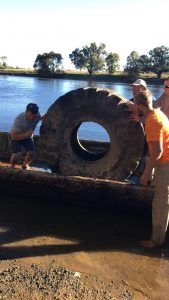There I was, standing waist deep in the James River, 1½ hours away from campus in Howardsville.
The river was about 3½ feet deep with the current strong, but I did have one hand on a fallen branch to hold myself steady against the current. Besides, I was not alone—five other canoes and a batteau were cruising down the River for the same purpose as well.
There I was, standing on a truck tire on the river bottom, still clinging tight to its steel rim.
I was trying to work the toe of my right foot down through a slot in the rim. I figured if I could do that, I could maybe lift it up with my foot just high enough to reach down and grab it with my hand and pull it up. Then, maybe Monica could reach it and we could dunk it under together to get rid of the heaps of clumpy silt molded to the tire’s insides like clay. That way, we could drag it to the bank, hoist it up, and heave it into our canoe, perching it somewhat precariously on top of the five other barnacle-lined tires we found in the last 15 feet of the River.
So it goes during The Annual Tireless James River Cleanup.
The trip was not what I was expecting at all. I was not expecting to see, in the midst of the sycamores, river birches, and white oak lining the banks, a carpet of tires lining the bottom of the James River right after canoeing down Goolsby’s Rapids. I was not expecting to be fully submerged under the clear yet somewhat murky waters of the James to retrieve a tire that I can’t even successfully retrieve because it weighs too much. And finally, I was not expecting to use eight people to pick up one enormous tire the size of a fully grown person .
It was all for the best though, as it was a very successful and enjoyable cleanup, with the entire group of us retrieving more than 50 tires together and canoeing six miles down the River. I only write this now to say, the next time you ponder tossing a tire into a nearby river, think of me.
Standing waist deep in the James River trying to retrieve it with my feet.


